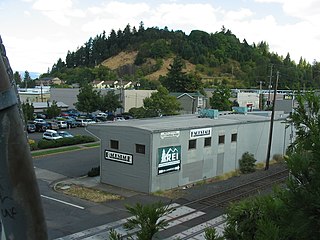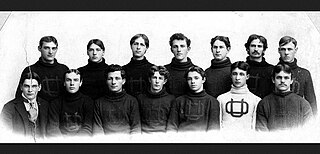
Eugene is a city in the U.S. state of Oregon, in the Pacific Northwest. It is at the southern end of the Willamette Valley, near the confluence of the McKenzie and Willamette rivers, about 50 miles (80 km) east of the Oregon Coast.

Oakridge is a city in Lane County, Oregon, United States. The population was 3,205 as of the 2010 census. It is located east of Westfir on Oregon Route 58, about 40 miles (64 km) east of Eugene and 150 miles (240 km) southeast of Portland. Surrounded by the Willamette National Forest and the Cascade Range, Oakridge is popular with outdoor enthusiasts for its hiking, mountain biking, wildflowers, fly fishing, birding, watersports, and the nearby Willamette Pass Resort.

Skinner Butte is a prominent hill on the north edge of downtown Eugene, Oregon, near the Willamette River. A local landmark, it honors city founder Eugene Skinner and is the site of the municipal Skinner Butte Park. During the early 1920s, the city's Ku Klux Klan members etched the letters "KKK" into the side of the butte and installed a cross near the top. Local Klan members were said to have burned the cross during meetings. The letters were removed and replaced with the letter "O" in the late 1920s. The cross was replaced several times since the Klan first erected it. However, the cross wasn't permanently removed until 1997.

Lane Community College is a public community college in Eugene, Oregon, with additional facilities in downtown Eugene, Florence, Cottage Grove, and the Lane Aviation Academy at Eugene Airport. Lane serves more than 26,000 credit and non-credit students annually in a 5,000 square-mile (~8047 km2) service district, including most of Lane County as well as individual school districts in Benton, Linn, and Douglas counties.

Goshen is an unincorporated community in Lane County, Oregon, United States. It is located at the junction of Oregon Route 58, Oregon Route 99, and Interstate 5.

McKenzie Bridge is an unincorporated community in Lane County, Oregon, United States, on the McKenzie River and within Willamette National Forest. It is along Oregon Route 126, about 53 miles (85 km) east of Eugene, between Rainbow and Belknap Springs. The McKenzie Bridge State Airport is about 4 miles (6.4 km) east of the community.

Finn Rock is an unincorporated community in Lane County, Oregon, United States. It is located on Oregon Route 126 and the McKenzie River, between the communities of Nimrod and Blue River, in the Willamette National Forest.

The 1895 Oregon Webfoots football team was an American football team that represented the University of Oregon in the 1895 college football season. It was the Webfoots' second season. They were led by head coach Percy Benson, previously a star player for the University of California team.

Camp Adair was a United States Army division training facility established north of Corvallis, Oregon, operating from 1942 to 1946. During its peak period of use, the camp was home to approximately 40,000 persons — enough to have constituted the second largest city in the state of Oregon. The camp was largely scrapped as government surplus following termination of World War II, with a portion of the site reconstituted as "Adair Air Force Station" in 1957.

McKenzie-Willamette Medical Center is an acute care hospital located in Springfield, Oregon, United States. Opened in 1955, it serves the Lane County area. McKenzie-Willamette is investor-owned, and accredited by the Joint Commission. Licensed for 114 hospital beds, the facility was the only hospital in Springfield until the Sacred Heart facility at RiverBend opened in August 2008.
The Oregon Land Conservation and Development Act of 1973, formally Oregon Senate Bills 100 and 101 of 1973, were pieces of landmark legislation passed by the Oregon State Senate in 1973 and later signed into law. It created a framework for land use planning across the state, requiring every city and county to develop a comprehensive plan for land use.
Siltcoos is an unincorporated community in Lane County, Oregon, United States. It is about 13 miles (21 km) south of Florence on the east shore of Siltcoos Lake.

Springfield is a city in Lane County, Oregon, United States. Located in the Southern Willamette Valley, it is within the Eugene-Springfield Metropolitan Statistical Area. Separated from Eugene to the west, mainly by Interstate 5, Springfield is the second-most populous city in the metropolitan area after Eugene. As of the 2010 census, the city has a total population of 59,403.
The Eugene Mall was a car-free zone in the heart of Eugene, Oregon, United States, designed to encourage pedestrian access to shopping and entertainment areas. Dedicated on February 13, 1971, the mall opened amid three days of fanfare and dreams of a revitalized downtown. Conflict over the scope and use of the mall began immediately and continued for 30 years until the last remaining parts of the mall were opened to automobile traffic. At that time, a former Eugene mayor commented that the city's dreams for a bright future just hadn't worked. Many residents, however, shared the much-earlier view of a former downtown merchant, that Eugene had sustained more damage from the mall than it would have from a natural disaster.

Lord Nelson "Nels" Roney was a building contractor and carpenter working primarily in the U.S. state of Oregon. He designed and built many of Oregon's early covered bridges, often using the Howe truss. Roney also built bridges for the Oregon and California Railroad from Roseburg, Oregon south to Redding, California, and he constructed commercial buildings and houses in Eugene, Oregon.
Lane County History Museum, located on the county fairgrounds in Lane County in Eugene, Oregon, United States, has ongoing exhibits on the Oregon Trail, the county courthouse, historic vehicles, selections of artifacts from across the county, and photographs. The museum also provides research materials by appointment in their closed stack library, school tours, a variety of public events, and runs an annual grant program for heritage outreach projects. The museum and the Lane County Clerk's Building near the museum entrance are both administered by the Lane County Historical Society.

Elijah Bristow (1788–1872) was the first white settler to stake a claim and build a permanent cabin in 1846 in the upper Willamette Valley, in what is now Lane County, Oregon, United States. He and his wife Susannah Gabbert Bristow established the first church and donated land for the first school in Pleasant Hill.

The main United States Post Office in Eugene, Oregon, is a 2-story Art Deco building designed by Gilbert Stanley Underwood and constructed in 1939. The front facade features blue and cream colored terracotta with black and buff colored accents, and pilasters separate multicolored window bays. The building is the only example of federal Art Deco architecture in Lane County, and it is the only federal building in Oregon to use multicolored terracotta. Murals painted by Carl Morris were installed in the lobby in 1943. The post office was added to the National Register of Historic Places in 1985. The corner at 5th and Willamette Streets contains three sites listed on the register.
















